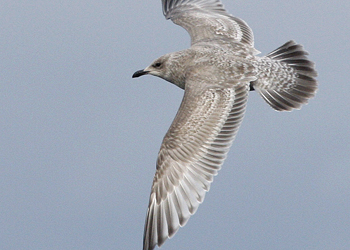 Thayer's Gull (thayeri)
Thayer's Gull (thayeri)
(last update: January 22, 2013)
Thayer's Gull 2cy April (1st cycle)
Below you will find a description of Chapter 36 THAYER'S GULL Larus thayeri, as published in one of the best Gull publication: "Gulls of the Americas" by Steve Howell & Jon Dunn.
"we" in the text below refers to the original authors. If any errors occur in this text, please let me know and mail to marsmuusseatgmaildotcom.
PART 1: IDENTIFICATION SUMMARY & TAXONOMY
PART 2: FIELD IDENTIFICATION SIMILAR SPECIES - ADULT
PART 3: FIELD IDENTIFICATION SIMILAR SPECIES - 1ST CYCLE
PART 4: FIELD IDENTIFICATION SIMILAR SPECIES - 2ND CYCLE
PART 5: RARER SPECIES
PART 6: DESCRIPTION AND MOLT - ADULT & 1ST CYCLE
PART 7: DESCRIPTION AND MOLT - 2ND & 3RD CYCLE
BELOW: PART 6
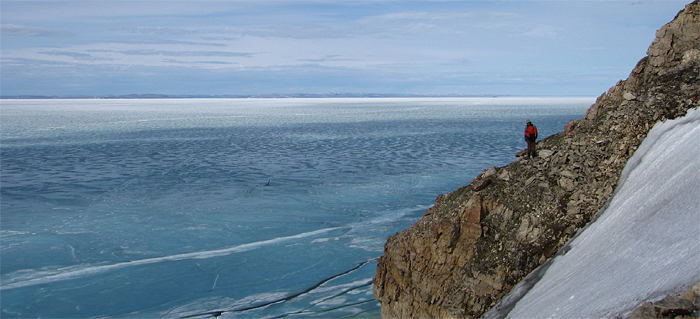
South Minto, Victoria Island (71.10N 117.42W) eastern range of breeding site of Thayer's Gull.
HABITAT AND BEHAVIOR
Breeds on cliffs and rocky islands in Canadian High Arctic. Adults winter mostly along or near the coast at bays, estuaries, and river mouths; first-cycle birds (and, to a lesser extent, other ages) also occur at lakes, duck ponds, dumps, parking lots, and other habitats where large gulls occur. Nonbreeding birds (especially adults) often in flocks (locally up to a few hundred birds but more often 20-100 birds). Thayer’s Gulls associate readily with other gulls and water birds but, at least in winter, they mostly avoid feeding areas dominated by the larger Western and Glaucous-winged Gulls. First-cycle birds often associate with groups of California Gulls at town and city parks with lakes, where they can be quite confiding. In winter, feeds on spawning fish in inshore waters and bays; also scavenges.
DESCRIPTION AND MOLT
Some adult and third-cycle putative or presumed Thayer’s Gulls have slaty gray wingtips and others have mostly whitish wingtips with limited gray markings. [Parmelee & MacDonald 1960; Snell 2002] Some first-cycle and second-cycle Thayer’s-like birds have pale brown wingtips and reduced dark pigmentation in the flight feathers. Some of these are probably hybrids with Iceland and Kumlien’s Gulls, but some may represent variation in pure Thayer’s, the limits of which have yet to be established.
Adult Cycle.
Complete PB molt (June/July-Nov./Jan.) produces adult basic plumage: head, neck, and underparts white; head, neck, and sometimes upper chest with variable (usually moderate to heavy) dusky mottling and streaking. Upperparts pale gray (Kodak 5-6) with slaty blackish wingtips (black on outer web of P10 and sometimes P9 extends to primary coverts; P4 and sometimes P5 unmarked); white scapular and tertial crescents; and white tips to outer primaries. Uppertail coverts and tail white. White trailing edge to secondaries (often hidden at rest) and inner primaries breaks into discrete white tips on outer primaries; P5/P6-P8 have white tongue-tips and blackish subterminal bands, P9-P10 typically have white mirrors or mirror-tongues; on P9, blackish on medial portion extends onto inner web, and an unbroken narrow blackish line runs along outer web across mirror region; P10 usually has a partial to complete blackish subterminal band. Underwings show pale smoky gray remiges with white trailing edge to secondaries and inner primaries continuing as a band of white tongue-tips and mirrors across outer primaries, a narrow slaty blackish subterminal band on outer primaries, and a dark leading edge to P10. Eyes brownish to pale lemon, orbital ring purplish pink. Bill yellowish (often greenish basally in winter) with orange-red to red gonydeal spot and sometimes a dark mark at gonys. Legs pink, perhaps duller during height of PB molt. Partial PA molt (Oct.-Feb./Apr.) produces adult alternate plumage: head and neck clean white (rarely before Mar./Apr.); white primary tips can be lost through wear. By spring, orbital ring brightens, bill brightens to lemon yellow with red gonydeal spot and lacks dark distal marks, legs rich pink.
First Cycle.
Juvenile (Aug.-Apr.): dark brown to medium gray-brown overall. Head, neck, and underparts variably streaked and mottled whitish, becoming whitish on vent and undertail coverts, which have broad sooty brown bars. Upperparts with buff (bleaching to dull whitish) scaly and notched edgings and markings, the greater coverts sometimes with lightly marked (or unmarked) bases. Upperpart markings typically scaly to checkered, often fairly contrasting and neatly marked, or frosty in fresh plumage (through late winter on some birds). Uppertail coverts whitish with strong dark barring. Tertials dark brown to dark gray-brown with notched whitish tips and distal edging. Wingtips blackish brown, contrastingly darker than tertials (and usually darker than tail), with whitish fringes or tips usually distinct. Pale panel on inner primaries distinctive on spread upperwing; outer primaries blackish brown with paler inner webs reaching shaft and forming a two-tone pattern that merges inward with pale inner primary panel. Secondaries dark brown, tipped whitish. Outer primary coverts plain brownish with narrow whitish tips. Tail dark brown, usually slightly paler than wingtips with whitish tip and whitish ribbing on outer web of R6: whitish basal barring on outer rectrices best seen when tail fully spread or from below. IN FLIGHT: brownish to gray-brown overall with dark outer webs to outer primaries (varying from a solid panel when wings not fully spread to a two-tone pattern when spread), pale inner primary panel, contrasting dark secondary bar, and broad dark brown distal tail band; underwings medium brown with underside of primaries often reflectively pale. Eyes dark, bill blackish, usually with variable dull flesh on basal two-thirds by early winter; legs flesh to flesh pink. PA1 molt (Nov.-May, does not include upperwing coverts) produces first alternate plumage: head, neck, chest, and flanks smoky gray to sooty gray with variable whitish streaking and mottling, and often mixed with bleached juvenal feathers (juvenal head can bleach to mostly whitish). A1 scapulars range from brownish gray to medium pale gray, typically with fine dark bars or wavy markings and ranging from fairly plain grayish to having dark bars or anchor patterns. Bill blackish with dull flesh to flesh pink basally, sometimes a fine pale horn tip; exceptionally flesh pinkish with a blackish distal third [Howell pers. obs]; legs flesh pink; eyes dark. Note that some birds retain most or all juvenal plumage through Apr. and can be very bleached, almost whitish in overall appearance, but note dark secondary bar and brownish tail, usually fairly protected from bleaching.
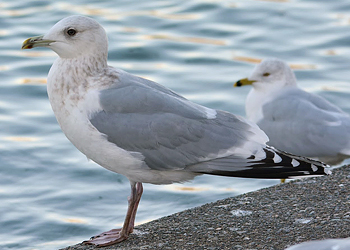

.jpg)
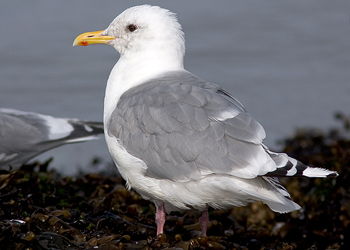
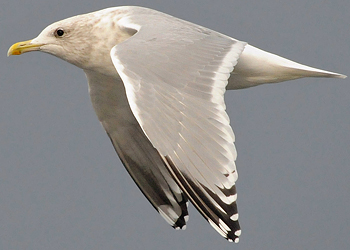
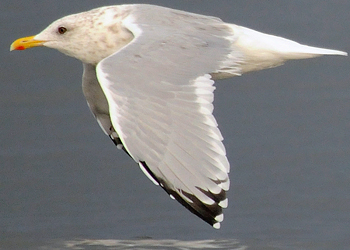
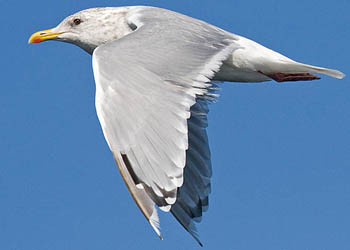

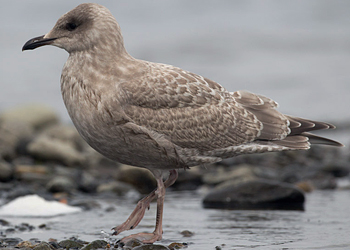
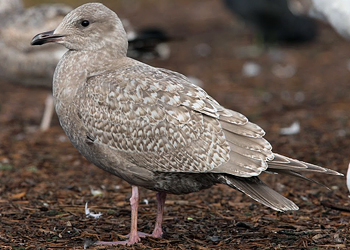
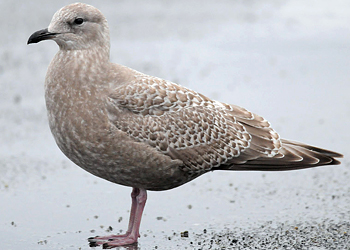
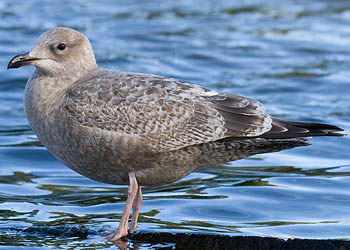

.jpg)

